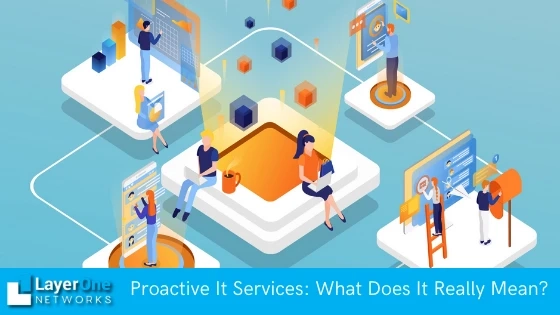In the technology space, a lot of companies, I mean a lot… talk about proactivity. So, yes, it's a buzzing word. But in the core concept of proactivity, there is value in it.
These days, you can't react to everything that could impact your technology. The reactive approach leads to system failure, up-gradation in technology, and data breaches.
But what does it state when it comes to IT services?
Are there any specific things your organization needs to do?
How can you assure that an IT service provider is constructively proactive instead of just giving lip service?
A single IT disaster can set your company back a month and, needless to say, what it can do to your budget. So, let's take a look at what proactive support entails.
Go ahead with proper maintenance
Are you considering a baseline for any service provider? It is a simple proactive IT management aspect to maintain it. There are certain tasks such as emergency security alerts and repairing of newly discovered vulnerabilities.
There is a specific approach to these tasks, and it can vary based on your
specific technology.
Patch Management
Security reinforcement needs to be performed when released for servers, PCs, or any other devices with operating systems. It is ruling these days. You should still perform other patches weekly.
Configuration Management
You should regularly review rights management and technical configuration so that your system can operate securely.
Antivirus and Endpoint Security Management
It relies on what type of solution you need to use to deal with devices' IT security and cybersecurity threats. First, tools must get maintenance to run with the latest versions and cover for any bugs.
Proactive monitoring
It is a broader subject to monitor and will differ dramatically based on what type of technology you use. Therefore, it is not a one-size-fits-all approach. Certain areas that monitoring can fit for your organization are:
Network monitoring
LANs/ WANs are like highways for cars. Traffic runs at a speed that can differ, but it is predictable, and often traffic can get backed up. It even stops entirely. When you look at network monitoring, the traffic similarly will determine failures and bottlenecks that break networks. It is essential, especially where on-premise servers and other technology are present.
Web Application Monitoring
Do you have any kind of web-facing application? You might know that users that hit your web application will interact with it. Let's say, for example, how long it takes for a page to load?
User Monitoring
There are a variety of areas where you can monitor users. Some of these have to do things like being logged in or working actively. Other areas make sure your accounts are not compromised, like monitoring from where a user connects. IT consulting firm will keep track of all of these.
Take charge of backup management.
Technology is used in the first place where the data is the key. The material is raw and needed to extract business value from your devices. Unlike a physical server, router, or any other hardware, data is often creative and unique. Unfortunately, it makes it difficult to replace and costly too. Proactive backup management is an important area where your IT service needs to stay on top.
Overall Management
Do you think you are backing up the correct data? Does it cause other technical problems if you back up too much? There are some check-ins for solutions to ensure you are getting what you need out of it. And you have to restore.
Proper evaluation
The one thing to know about your backup is working to operate with planning. You need to make sure that your data comes back if you plan to perform a restore. Regular testing is a proper measure that helps you guarantee the ethics of data in an incident.
Well thought planning
In technology, everything is not monitored, and the system is checked. A huge part of technology is actively looking forward and planning it strategically. here are some specific areas you should include:
You don't want to stay in a place where Windows 7 is hitting the end of life, and your budget is insufficient to make proper changes. It will keep your system secure and supportable. Budgeting
Standards Review
There are times when technology standards and practices change. A good planning session will help you identify what technology should modify that suits today's standards. Even good decisions that are made upfront need adjustment down the line to stay ahead of threats. Also, it continues to be productive. Maintenance Review
Maintenance becomes tough or less effective as the system simply doesn't operate once the way it did. There comes the point where the complexity to maintain is not worth the effort. You should consider them part of your strategic planning if your approach is to maintain and achieve that it works for you or against you.
Wrapping up:
Here, you can create a technology management plan that incorporates most or all items addressed in this blog. Then, you should be in a good place to minimize the risk associated with technology while maximizing its productivity. The proactive IT services will mean something a bit different to every organization. But at the end of the day, you need to recognize that you cannot wait for an incident to begin securing your technology assets.


